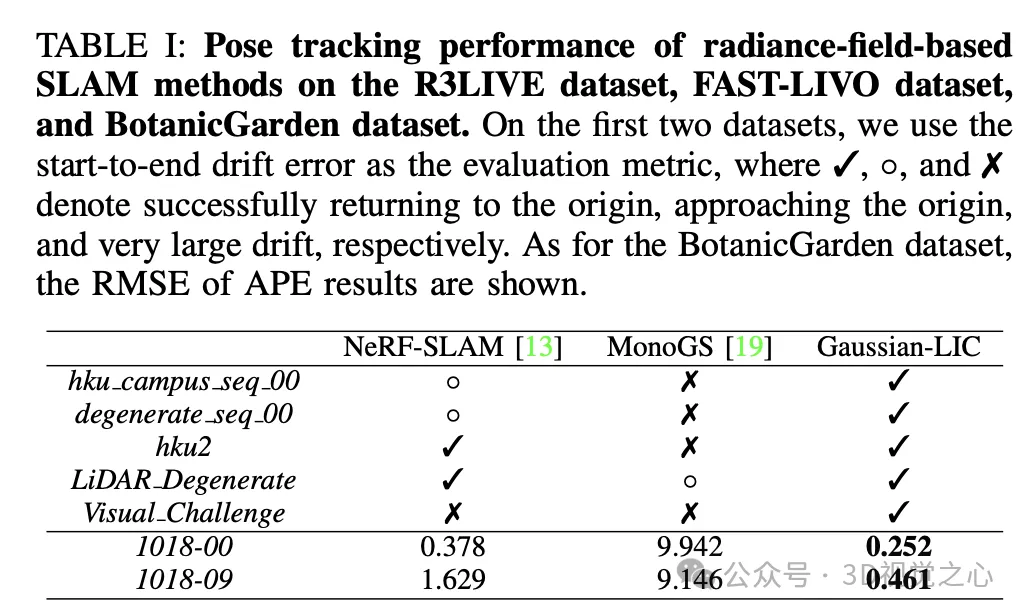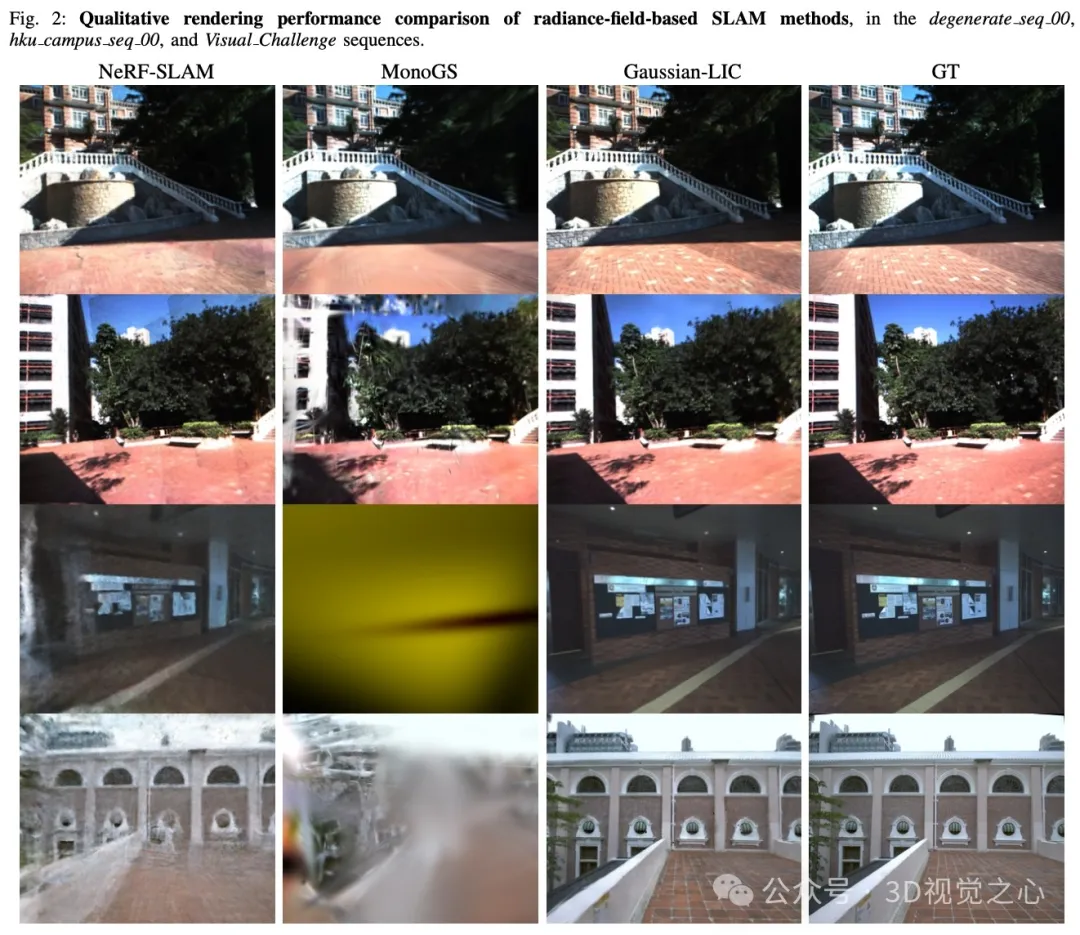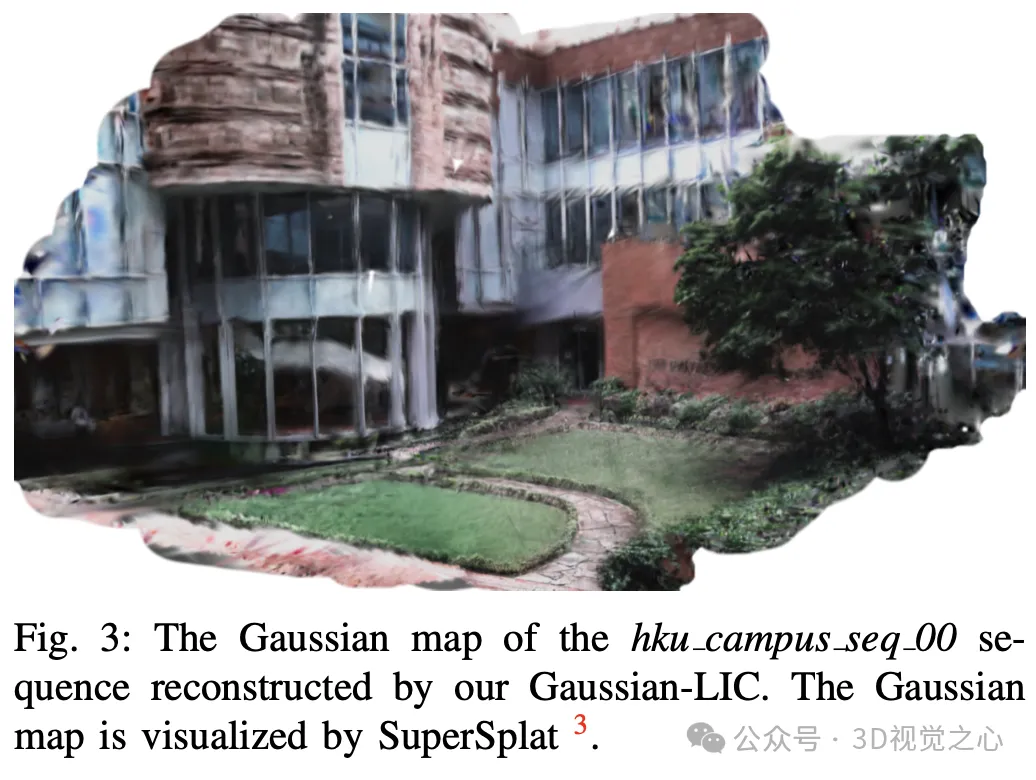多重感測器與3DGS的結合
「基於3D空間中的取樣進行計算密集型SLAM任務所需的即時能力」的隱含表達式需要基於NeRF-based SLAM方法。 3DGS以其快速的渲染速度和優越的視覺品質而引人注目。作為一種明確且可以解釋的表達法,3DGS使得場景編輯變得簡單,有利於眾多下游任務的執行。
現有的基於輻射場的SLAM系統,主要在光照良好的小規模室內環境中進行測試,並使用順序RGB-D或RGB輸入獲得令人滿意的結果。當這些方法擴展到具有挑戰性的大規模不受控制的室外場景時將會遇到困難,例如具有挑戰性的光照條件、雜亂的背景和高度動態的自身運動。
使用Gaussian-LIC 透過融合來自多個感測器的數據,包括3D雷射雷達、IMU和相機(稱為ALIC),在不受控制的室外場景中
- 首個基於雷射雷達慣性相機融合的3DGS-SLAM系統,實現了高度精確的姿態追蹤和逼真的線上地圖建構。
- 利用順序著色光達點雲作為先驗,以線上方式重建高斯地圖。利用精心設計的一系列策略,逐步擴展高斯地圖並自適應地控制其密度,以實現高效率和準確性。
- 在室內外場景中經過廣泛驗證,展示了逼真地圖製作的最新表現。在惡劣條件下表現出穩健性,包括高度動態運動、低照明和缺乏幾何結構和視覺紋理。
具體方法
如圖1所示是LIC-SLAM系統流程。

3DGS的表示
#將場景表示為各向異性的3D高斯集合,每個高斯的變異數:

將3D高斯投影到影像平面上,獲得2D高斯分佈:

投影獲得的2D高斯透過不透明度加權方程式影響像素:

渲染輪廓圖像以確定像素是否包含了足夠的來自高斯地圖的資訊:

LiDAR-IMU-Camera里程計
里程計採用了先前的工作Coco-LIC作為追蹤前端,一個連續時間緊密耦合的雷射雷達慣性攝影機測距系統。透過整合三種互補的感測器,Gaussian-LIC實現了強大、即時和高精度的姿態估計,從而促進了整個SLAM系統的運作。
每當最新的 (本文為0.1秒)內的雷射雷達慣性攝影機資料被累積時,會基於因子圖有效地優化該時間間隔內的軌跡:
- 光達點雲到地圖
- 影像到地圖的視覺因子
- IMU因子
- 偏差因子
在時間間隔內我們僅利用最新的影像進行優化。
Gaussian-LIC維護一個以0.1公尺解析度儲存在體素中的全域雷射雷達地圖。在優化當前時間間隔內的軌跡後,為了提高效率,僅將該時間段內四分之一的激光雷達點轉換為世界坐標並附加到體素中,以確保每個體素中的激光雷達點之間的距離應大於0.05米,以減少冗餘。對於成功附加的光達點,將它們投影到最新的圖像上,並透過查詢像素值為其著色。隨後,它們與估計的相機姿態的最新圖像一起發送到映射線程,被視為一幀。
基於3DGS的逼真建圖
隨著持續輸入:估計的相機姿態、無畸變影像、著色的雷射雷達點,建圖模組逐步建構和優化高斯地圖,主要分4步:
- 初始化:利用在第一個時間間隔內接收到的所有雷射光測點來創建新的高斯分佈。為了減輕混疊偽影,我們為距離較近的高斯分佈分配較小的尺度,而對於遠離影像平面的高斯分佈則分配較大的尺度:

- Extension: Normally, each frame received captures the geometry and appearance of a new viewing area. In order to avoid duplication or extremely similar information redundancy, first render a contour image from the current image view according to equation (6), and generate a mask to select the current Gaussian Unreliable pixels in the map and tend to observe new areas, only lidar points that can be projected onto the selected pixel will be exploited:

- Optimization: Optimization using all received images is computationally infeasible for our online incremental mapping system, so every fifth image frame is considered a keyframe. To keep the computational complexity bounded for efficiency, we select active keyframes to optimize the Gaussian map, including the first and last keyframe, and other randomly selected keyframes, avoiding the catastrophic forgetting problem and maintaining the geometric consistency of the global map. We randomly shuffle the selected keyframes and iterate through each keyframe one by one, optimizing the map by minimizing the re-rendering loss:

- Adaptive Control: LiDAR scanning may not cover the entire scene, especially in borderless outdoor environments. It is therefore necessary to perform adaptive control to densify the Gaussian map within unit volume. The original strategy handles Gaussians with large gradients at fixed intervals, while in incremental mode, since they often have not converged yet, recently added Gaussians may be incorrectly cloned or split due to having large gradients. The solution is to classify the existing Gaussian distributions into stable and unstable categories, and only densify the stable Gaussian distributions.
experiment





Summary and Discussion
Gaussian-LIC is a novel LiDAR-inertial-camera radiation field SLAM system, It achieves the dual functions of highly accurate tracking and realistic online reconstruction with 3D Gaussian splatter. Shaded LiDAR points in world coordinates produced by efficient LiDAR-inertial-camera odometry are used as good priors to assist in the incremental building of Gaussian maps with significantly better generalization in indoor and outdoor scenes .
Room for improvement:
- Try to remove unnecessary Gaussian distributions in the map.
- Supports various lidar, currently only trying to use solid-state lidar.
- The camera's automatic exposure and motion blur affect the visual quality of realistic maps.
The above is the detailed content of Gaussian-LIC: The first multi-sensor fusion 3DGS-SLAM system (Zhejiang University & TUM). For more information, please follow other related articles on the PHP Chinese website!


















